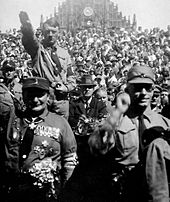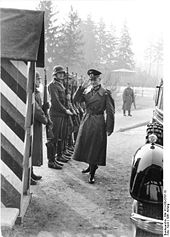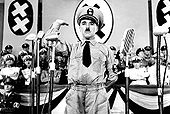- Nazi salute
-
This article is about the fascist salute used in Germany. For fascist salutes in other countries, see Roman salute.
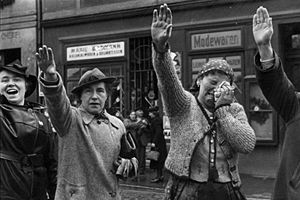 People of Eger, in the Sudetenland (now Cheb, Czech Republic), greet German soldiers with the Hitler salute in October 1938
People of Eger, in the Sudetenland (now Cheb, Czech Republic), greet German soldiers with the Hitler salute in October 1938
The Nazi salute, or Hitler salute (German: Hitlergruß, literally Hitler Greeting or Deutscher Gruß, German Greeting), was a gesture of greeting in Nazi Germany usually accompanied by saying, Heil Hitler! ["Hail Hitler!"], Heil, mein Führer ["Hail, my leader!"], or Sieg Heil! ["Hail victory!"]. Characteristic of a cult of personality, it was adopted in the 1930s by the Nazi Party to signal obedience to the party's leader Adolf Hitler and to glorify the German nation and later the war effort. The salute was mandatory for civilians[1] but optional for military personnel, where the traditional military salute was retained until shortly after the failed assassination attempt on Hitler in 1944.[2] Currently, use of this form of greeting constitutes a criminal offense in Germany, Austria and the Czech Republic.[3] Depending on the circumstances, the greeting might constitute a criminal offense in Sweden as a hate speech act.[citation needed]
Contents
Description
To perform the salute, it was customary to extend one's right arm straight in front of oneself, raise it at least to eye level, straighten the hand so that it is parallel to the arm[4] and say emphatically, Heil Hitler!, or at least Heil! If one saw an acquaintance at a distance, it sufficed to simply raise the right hand.[4] If one encountered a superior, one would also say, Heil Hitler.[4] If physical disability prevented raising the right arm, it was acceptable to raise the left.[5] The form Heil, mein Führer! was for direct address to Hitler.[6] Sieg Heil was repeated as a chant on public occasions.[6] Written communications would be concluded with either Mit deutschem Gruß [With German greeting], or, simply, Heil Hitler.[7]
In later periods Hitler himself used a modified German salute, not stretching his full right arm, but bending it while holding an open hand towards the greeted at shoulder's height.
Origins and adoption
See also: Roman saluteThe oral greeting Heil became popular in the pan-German movement around 1900.[8] As a manner of address, Führer was introduced by Georg Ritter von Schönerer, who considered himself leader of the Austrian Germans.[8]
The salute gesture is widely believed to be based on an ancient Roman custom.[9] However, no Roman work of art depicts it, nor does any Roman text describe it.[9] Jacques-Louis David's painting Oath of the Horatii (1784) seems to be the starting point for the gesture that became known as the Roman Salute.[10][11] The gesture and its identification with ancient Rome was advanced in other French neoclassic art.[12][13][14] This was further elaborated upon in popular culture during the late 19th and early 20th centuries in plays and films that portrayed the salute as an ancient Roman custom.[15] This included the silent film Cabiria (1914), whose screenplay was written by the Italian ultra-nationalist Gabriele d'Annunzio, arguably the forerunner of Benito Mussolini.[16] In 1919, when he led the occupation of Rijeka, d'Annunzio adopted the style of salute depicted in the film as a neo-Imperialist ritual;[17] and it was quickly adopted by the Italian Fascist Party.[17]
By autumn 1923, some members of the Nazi Party were using the rigid, outstretched right arm salute to greet their leader; and the leader responded by raising his own right hand crooked back at the elbow, palm opened upwards, in a gesture of acceptance.[18] In 1926, the Heil Hitler salute was made compulsory.[5] It functioned as a display of commitment to the Party and a declaration of principle to the outside world.[19] Yet, the drive to gain acceptance did not go unchallenged.[19]
Some party members challenged the legitimacy of the so-called Roman salute employed by Fascist Italy, as not Germanic.[19] In response, efforts were made to establish its pedigree by inventing a tradition after the fact.[19] In June 1928, Rudolph Hess published an article titled "The Fascist Greeting", which claimed the gesture was used in Germany as early as 1921, before the Nazis had heard about the Italian Fascists.[20] He admits in the article: "The NSDAP's introduction of the raised-arm greeting approximately two years ago still gets some people's blood boiling. Its opponents suspect the greeting of being un-Germanic. They accuse it of merely aping the (Italian) Fascists",[21] but goes on to ask, "and even if the decree from two years ago (Hess's order that all party members use it) is seen as an adaption of the Fascist gesture, is that really so terrible"?[21] Ian Kershaw points out that Hess did not deny the likely influence from Fascist Italy, even if indeed the salute had been used sporadically in 1921 as Hess claimed.[22]
On the night of 3 January 1942, Hitler said of the origins of the salute:[23]
I made it the salute of the Party long after the Duce had adopted it. I'd read the description of the sitting of the Diet of Worms, in the course of which Luther was greeted with the German salute. It was to show him that he was not being confronted with arms, but with peaceful intentions. In the days of Frederick the Great, people still saluted with their hats, with pompous gestures. In the Middle Ages the serfs humbly doffed their bonnets, whilst the noblemen gave the German salute. It was in the Ratskeller at Bremen, about the year 1921, that I first saw this style of salute. It must be regarded as a survival of an ancient custom, which originally signified: "See, I have no weapon in my hand!" I introduced the salute into the Party at our first meeting in Weimar. The SS at once gave it a soldierly style. It's from that moment that our opponents honored us with the epithet "dogs of Fascists".—Adolf Hitler, Hitler's Table TalkFrom 1933 to 1945
The compulsory use of the Hitler salute for all public employees followed a directive issued by Reich Minister of the Interior Wilhelm Frick on 13 July 1933, one day before the ban on all non-Nazi parties.[1] The decree also required the salute during the singing of the national anthem and the Horst-Wessel-Lied.[1] It stipulated that "anyone not wishing to come under suspicion of behaving in a consciously negative fashion will therefore render the Hitler Greeting".[1] A rider to the decree, added two weeks later, stipulated that if physical disability prevented raising of the right arm, "then it is correct to carry out the Greeting with the left arm."[5] On 27 September, prison inmates were forbidden to use the salute,[24] as were Jews by 1937.[25]
By the end of 1934, special courts were established to punish those who refused to salute.[26] Offenders, such as Protestant preacher Paul Schneider, faced the possibility of being sent to a concentration camp.[26] Foreigners were not exempt from intimidation. For example, the Portuguese Consul General was beaten by members of the Sturmabteilung for remaining seated in a car and not saluting a procession in Hamburg.[27] Reactions to inappropriate use were not merely violent but sometimes bizarre.[28] For example, a memo dated 23 July 1934 sent to local police stations stated: "There have been reports of traveling vaudeville performers training their monkeys to give the German Greeting....see to it that said animals are destroyed".[28]
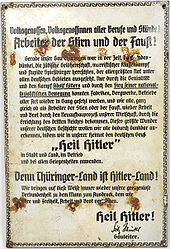 Appeal by Fritz Sauckel to show gratitude by using the Hitler salute (ca. 1934)
Appeal by Fritz Sauckel to show gratitude by using the Hitler salute (ca. 1934)
The salute became an ordinary way of life.[29] Postmen used the greeting when they knocked on people's doors to deliver packages or letters.[29] Small metal signs that reminded people to use the Hitler salute were displayed in public squares and on telephone poles and street lights throughout Germany.[30] Department store clerks greeted customers with “Heil Hitler, how may I help you?”[29] Dinner guests brought glasses etched with the words "Heil Hitler" as house gifts.[29]
Children were indoctrinated at an early age.[31] Kindergarten children were taught to raise their hand to the proper height by hanging their lunch bags across the raised arm of their teacher.[31] At the beginning of first grade primers was a lesson on how to use the greeting.[31] The greeting found its way into fairy tales, including classics like Sleeping Beauty.[31] Students and teachers would salute each other at the beginning and end of the school day, between classes, or whenever an adult entered the classroom.[32]
Some athletes used the Nazi salute in the opening ceremony of the 1936 Berlin Olympics as they passed by Adolf Hitler in the reviewing stand.[33] This was done by delegates from Afghanistan, Bermuda, Bulgaria, Bolivia, France, Greece, Iceland, Italy and Turkey.[33] The Bulgarian athletes performed the Nazi salute and broke into a goose-step;[33] Turkish athletes maintained the salute all around the track.[34] There is some confusion over the use of the salute, since the stiff-arm Nazi salute could have been mistaken for an Olympic salute, with the right arm held out at a slight angle to the right from the shoulder.[33] According to the American sportswriter Jeremy Schaap, only half of the athletes from Austria performed a Nazi salute, while the other half gave an Olympic salute. According to the historian Richard Mandell, there are conflicting reports on whether athletes from France performed a Nazi salute or an Olympic Salute.[34]
The Wehrmacht refused to adopt the Hitler salute and was able for a time to maintain its own customs.[35] A compromise edict from the Reich Defense Ministry, released on 19 September 1933, required the Hitler salute of soldiers and uniformed civil servants while singing the Horst Wessel Lied and national anthem, and in non-military encounters both within and outside the Wehrmacht (for example, when greeting members of the civilian government). At all other times they were to use their traditional salutes.[35] Only after the 20 July Plot in 1944 were the military forces of the Third Reich ordered to replace the standard military salute with the Hitler salute.[36] The order went into effect on 24 July 1944, four days after the attempt on Hitler's life in Rastenburg.[36]
On the night of 3 January 1942, Hitler stated the following about the compromise edict of 1933:[23]
I imposed the German salute for the following reason. I'd given orders, at the beginning, that in the Army I should not be greeted with the German salute. But many people forgot. Fritsch drew his conclusions, and punished all who forgot to give me the military salute, with fourteen days' confinement to barracks. I, in turn, drew my conclusions and introduced the German salute likewise into the Army.—Adolf Hitler, Hitler's Table TalkDespite indoctrination and punishment, the salute was ridiculed by some people. Since "heil" is also the imperative of the German verb "heilen" ("to heal"), a common joke in Nazi Germany was to reply with "Is he sick?", "Am I a doctor?", or "You heal him!"[37] Jokes were also made by distorting the phrase. So for example Heil Hitler might become Ein Liter ("One liter").[37] Cabaret performer Karl Valentin would quip, "It's lucky that Hitler's name wasn't 'Kräuter'. Otherwise, we'd have to go around yelling Heilkräuter ('medicinal herbs')".[37]
Satirical use of the salute dates back to anti-Nazi propaganda in Germany before 1933. In 1932, photomontage artist John Heartfield used Hitler's modified version, with the hand bent over the shoulder, in a poster that linked Hitler to Big Business. A giant figure representing right-wing capitalists stands behind Hitler, placing money in his hand, suggesting 'backhand' donations. The caption is, "the meaning of the Hitler salute" and "Millions stand behind me".[38]
Sieg Heil
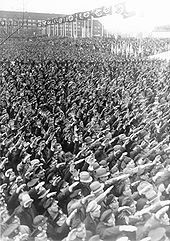 A mass rally on Tempelhof field, 1 May 1935
A mass rally on Tempelhof field, 1 May 1935
Sieg Heil was a ritualistic chant used at mass rallies, where enthusiastic crowds answered Heil to the call of Sieg ("victory").[39] For example, at the 1934 Nuremberg Rally, Rudolf Hess ends his climactic speech with, "The Party is Hitler. But Hitler is Germany, just as Germany is Hitler. Hitler! Sieg Heil!"[40] At his total war speech delivered in 1943, audiences shouted Sieg Heil as Joseph Goebbels solicited from them "a kind of plebiscitary 'Ja' to self destruction in a war which Germany could by now neither win nor end through negotiated peace".[41] In correspondence with high-ranking nazi officials, letters were usually signed with "Heil Hitler".[42]
On 11 March 1945, less than two months before the capitulation of Nazi Germany, a memorial for the dead of the war was held in Marktschellenberg, a small town near Hitler's Berghof residence.[43] The historian Ian Kershaw reports, "When the leader of the Wehrmacht unit at the end of his speech called for a Sieg Heil for the Fuhrer, it was returned neither by the Wehrmacht present, nor by the Volkssturm, nor by the spectators of the civilian population who had turned up. This silence of the masses... probably reflects better than anything else, the attitudes of the population."[43]
The Swing Kids (German: Swing Jugend) were a group of middle-class teenagers who consciously separated themselves from Nazism and its culture, greeting each other with 'Swing-Heil!' and addressing one another as 'old-hot-boy'.[44] This playful behaviour was dangerous for participants in the subculture; on 2 January 1942, Heinrich Himmler ordered that the leaders be put in concentration camps to be drilled and beaten.[44]
Reactions outside Nazi Germany
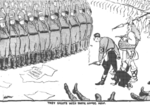 "They salute with both hands now" A political cartoon in the London Evening Standard 3 July 1934, depicting the SA surrendering to Hitler after the Night of the Long Knives.
"They salute with both hands now" A political cartoon in the London Evening Standard 3 July 1934, depicting the SA surrendering to Hitler after the Night of the Long Knives.
In England, the cartoonist David Low caricatured members of the Sturmabteilung during Night of the Long Knives in 1934 –with their hands raised to surrender– with the caption "They salute with both hands now".[45]
In the United States, Charlie Chaplin produced and directed a comedy film called The Great Dictator that satirised Adolf Hitler and Nazism and portrayed the protagonist, Adenoid Hynkel, as ridiculously obsessed with the salute. For instance, when he passes the famous statues of The Thinker and Venus de Milo, they appear in a saluting posture.[46] At the film's first release in October 1940, the United States was still formally at peace with Nazi Germany. After America entered the war, Spike Jones released the derisory song "Der Führer's Face", in which Heil was accompanied throughout by blowing a raspberry.[47]
Because of the similarity between the Bellamy salute in the United States and the Nazi salute, President Franklin D. Roosevelt instituted the hand-over-the-heart gesture as the salute to be rendered by civilians during the Pledge of Allegiance and the national anthem in the United States, instead of the Bellamy salute.[48] This was done when Congress officially adopted the Flag Code on 22 June 1942.[49]
Post-1945
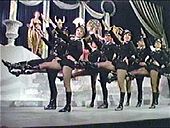 Dancing stormtroopers in Springtime for Hitler (1968)
Dancing stormtroopers in Springtime for Hitler (1968)
Today in Germany, Nazi salutes in written form, vocally, and even straight-extending the right arm with or without the phrase, are forbidden.[50][51] It is a criminal offence punishable by up to three years of prison (Strafgesetzbuch section 86a).[51][52] Usage for art, teaching and science is exempt from punishment unless "the existence of an insult results from the form of the utterance or the circumstances under which it occurred".[52] Use of the salute has also been forbidden by law in Austria since the end of World War II.
Usage that is "ironic and clearly critical of the Hitler Greeting" is exempt, and this exemption has led to legal debates as to what constitutes ironic use of the salute.[53] One recent case involved Prince Albrecht of Hanover, who was brought to court after using the gesture as a commentary on the behavior of an overly zealous airport baggage inspector.[53] On 23 November 2007, the Amtsgericht Cottbus sentenced Horst Mahler to six months of imprisonment without parole for having, according to his own claims, ironically performed the Hitler salute when reporting to prison for a nine-month term a year earlier.[54] The following month, a pensioner named Roland T was given a prison term of five months for, amongst other things, training his dog Adolf to raise his right paw in a Nazi salute every time the command "Heil Hitler!" was uttered.[55]
Versions of the salute are used by neo-Nazis, who also use the number 88 to stand for "Heil Hitler" (the 8 standing for H, the eighth letter of the alphabet).[56] One version is the so-called Kühnen salute with extended thumb, index and middle finger, also forbidden in Germany.[57] In Switzerland, Neo-Nazis are usually seen to perform this salute. The Swiss Rütlischwur, the traditional oath of pledge sworn at the founding of Switzerland in 1291, was also made with the three fingers extended, although the arm was not fully extended as in the Hitler pledge.
Satirical displays of the salute continued after the war. A notable example is Mel Brooks' comedy film The Producers, in which the Hitler salute is performed as a can-can dance in the fictional musical Springtime for Hitler.[58] Another example is Stanley Kubrick's Dr. Strangelove, whose eponymous character played by Peter Sellers had a 'possessed' arm which would independently spring into a Nazi salute (when not attempting to strangle its owner).[59]
The border between satirical and offensive usage of the term "Sieg Heil" is sometimes ambiguous. On 1 December 2003, Dieudonné M'bala M'bala appeared live on a television show, disguised as a Haredi (Orthodox) Jew making the Hitler salute and bellowing "Isra-Heil".[60] He was cleared of charges of antisemitism in a Paris court after the judge said this was not an attack against Jews in general but against a type of person "distinguished by their political views".[61] At the European Parliament election, 2004, Dieudonné was candidate of the extreme left-wing party "Euro-Palestine", but left a few months after the election because of disagreements with its Jewish leaders.[62]
Notes
- ^ a b c d Kershaw (2001) p.60
- ^ Büchner, Alex (1991). German Infantry Handbook, 1939–1945: Organization, Uniforms, Weapons, Equipment, Operations. Schipper Publishing. ISBN 978-0887402845
- ^ Czech Republic: A German put in jail for Nazi salute Global Voices, 15 August 2008
- ^ a b c Grunberger, Richard (1995). The 12-year Reich: a social history of Nazi Germany, 1933–1945 (illustrated ed.). Da Capo Press. ISBN 0306806606, 9780306806605.
- ^ a b c Kershaw (2001), p. 26.
- ^ a b Lepage, Jean-Denis G. G. (2008). Hitler Youth, 1922–1945: An Illustrated History (illustrated ed.). McFarland. p. 70. ISBN 0786439351, 9780786439355.
- ^ Tilman (2009), p. 15.
- ^ a b Mommsen, Hans (2003). The Third Reich Between Vision and Reality: New Perspectives on German History 1918–1945. German Historical Perspectives. Volume 12. Berg Publishers. p. 28. ISBN 859736270, 9781859736272.
- ^ a b Winkler (2009) p. 2
- ^ Winkler (2009), p. 55.
- ^ Boime, Albert (1987). Art in an age of revolution, 1750–1800. Social history of modern art. Volume 1. University of Chicago Press. pp. 400–401. ISBN 0226063348, 9780226063348. Boime states "The brothers stretch out their arms in a salute that has since become associated with tyranny. The "Hail Caesar" of antiquity (although at the time of the Horatti a Caesar had yet to be born) was transformed into the "Heil Hitler" of the modern period. The fraternal intimacy brought about by the Horatii's dedication to absolute principles of victory or death ... is closely related to the establishment of the fraternal order ... In the total commitment or blind obedience of a single, exclusive group lies the potentiality of the authoritarian state."
- ^ Boime, Albert (1993). Art in an age of Bonapartism, 1800–1815. Social history of modern art. 2 (reprint, illustrated ed.). University of Chicago Press. p. 46.
- ^ Winkler (2009), p. 51.
- ^ Winkler (2009), p. 40.
- ^ Winkler (2009), pp. 70–101.
- ^ Winkler (2009), pp. 74–101.
- ^ a b Falasca-Zamponi, Simonetta (2000). Fascist spectacle: the aesthetics of power in Mussolini's Italy. Studies on the history of society and culture. 28 (illustrated ed.). University of California Press. pp. 110–113. ISBN 0520226771, 9780520226777.
- ^ Evans, Richard J. (2005). "The Rize of Nazism". The Coming of the Third Reich (reprint, illustrated ed.). Penguin Group. pp. 184–185. ISBN 0143034693, 9780143034698.
- ^ a b c d Tilman (2009), p. 55.
- ^ Tilman (2009), pp.55–56
- ^ a b Tilman (2009), p. 56.
- ^ Kershaw, Ian (2000). Hitler, 1889–1936: hubris (illustrated ed.). W. W. Norton & Company. pp. 294, 689. ISBN 0393320359, 9780393320350.
- ^ a b Hitler, Adolf (1 October 2000). Bormann, Martin. ed. Hitler's Table Talk 1941–1944. trans. Cameron, Norman; Stevens, R.H. Preface and Introduction: The Mind of Adolf Hitler by H.R. Trevor-Roper (3rd ed.). London: Enigma Books. pp. 172–173. ISBN 1929631057.
- ^ Wireless to THE NEW YORK TIMES (27 September 1933). "Nazi Salute Banned in Prisons". The New York Times: p. 12. http://select.nytimes.com/mem/archive/pdf?res=F60B10FC3E541A7A93C5AB1782D85F478385F9. Retrieved 26 February 2010.
- ^ Tilman (2009), p. 51.
- ^ a b Tilman (2009), p. 61.
- ^ Shore, Zachary (2003). What Hitler knew: the battle for information in Nazi foreign policy (illustrated ed.). Oxford University Press US. p. 33. ISBN 0195154592, 9780195154597.
- ^ a b Tilman (2009), p. 60.
- ^ a b c d Tilman (2009), p. 33
- ^ Tilman (2009), p. 34.
- ^ a b c d Tilman (2009), p. 35.
- ^ Tilman (2009), p. 38.
- ^ a b c d Schaap, Jeremy (2007). Triumph: the untold story of Jesse Owens and Hitler's Olympics. Houghton Mifflin Harcourt. pp. 163–166. ISBN 0618688226, 9780618688227.
- ^ a b Mandell, Richard D. (1987). The Nazi Olympics. Sports and society (illustrated, reprint ed.). University of Illinois Press. p. 149. ISBN 0252013255, 9780252013256.
- ^ a b Tilman (2009) pp. 80–82.
- ^ a b Tilman (2009), p. 82.
- ^ a b c Tilman (2009), p. 44.
- ^ Jay, Martin (2001). "From Modernism to Post-Modernism". In T. C. W. Blanning. The Oxford illustrated history of modern Europe. Oxford Illustrated Histories (illustrated, reissue ed.). Oxford University Press. p. 261. ISBN 0192854267, 9780192854261.
- ^ Tilman (2009), p. 32.
- ^ Kershaw (2001), p. 69.
- ^ Kershaw (2000), pp. 561–562.
- ^ Klee, Kulturlexikon, S. 227.
- ^ a b Kershaw (2000), p. 766.
- ^ a b Willett, Ralph (May 1989). "Hot Swing and the Dissolute Life: Youth, Style and Popular Music in Europe 1939–49". Popular Music (Cambridge University Press) 8 (2): 161. JSTOR 853465.
- ^ Kelly, Nigel; Martyn J. Whittock (1995). The twentieth century world. Heinemann History Study Units Series (illustrated ed.). Heinemann. p. 46. ISBN 0435312928, 9780435312923.
- ^ Schechter, Joel (1994). Satiric impersonations: from Aristophanes to the Guerrilla Girls (illustrated ed.). SIU Press. p. 67. ISBN 0809318687, 9780809318681.
- ^ Taruskin, Richard (2009). Music in the Late Twentieth Century. Oxford History of Western Music. 5 (illustrated ed.). Oxford University Press US. p. 505. ISBN 0195384857, 9780195384857.
- ^ Bishop, Ronald (2007). "A Case of First Impression". Taking on the Pledge of Allegiance: the news media and Michael Newdow's Constitutional challenge. SUNY Press. p. 27. ISBN 0791471810, 9780791471814.
- ^ Leepson, Marc (2006). Flag: An American Biography. Macmillan. p. 171. ISBN 0312323093.
- ^ "Rechtsextremismus – Straftaten". hagalil.com. http://www.hagalil.com/deutschland/rechts/erkennungszeichen/rechtsextremismus.htm. Retrieved 24 February 2010.
- ^ a b Tilman (2009), pp. 94–95.
- ^ a b "Criminal Code (Strafgesetzbuch, StGB)". Federal Law Gazette I,. 13 November 1998. pp. 945, p. 3322. http://www.iuscomp.org/gla/statutes/StGB.htm#86aSection. Retrieved 14 February 2010.
- ^ a b Tilman (2009), p. 95.
- ^ "Sechs Monate für Hitlergruß" (in German). Die Zeit/dpa. 23 November 2007. http://www.zeit.de/online/2007/48/mahler-urteil.
- ^ Paterson, Tony (21 December 2007). "Dog's Nazi salute lands owner in jail for five months". The Independent (UK). http://www.independent.co.uk/news/world/europe/dogs-nazi-salute-lands-owner-in-jail-for-five-months-766438.html. Retrieved 1 March 2010.
- ^ Tilman (2009), p. 94.
- ^ "Kühnengruß oder sechs Bier bei FPÖ-Parteitag?" (in German). Kleine Zeitung. 27 May 2009. http://www.kleinezeitung.at/nachrichten/politik/1989141/index.do. Retrieved 27 August 2009. Second paragraph: "The Kühnengruß is regarded as a variation of the Hitler salute. In it the right arm is extended with three fingers spread. In Austria, unlike Germany, the salute is not prohibited".
- ^ Finney, Gail (2006). Visual culture in twentieth-century Germany: text as spectacle. Indiana University Press. p. 237. ISBN 0253347181, 9780253347183.
- ^ Goodchild, Peter (2004). Edward Teller, the real Dr. Strangelove (illustrated ed.). Harvard University Press. p. xxi. ISBN 0674016696, 9780674016699.
- ^ Dieudonné, la promo par le pire, 24 heures, 7 January 2009.
- ^ "French comic 'not anti-Semitic'". BBC. 27 May 2004. http://news.bbc.co.uk/1/hi/world/europe/3755013.stm. Retrieved 7 May 2009.
- ^ Dieudonné sur une pente très glissante, Euro-Palestine, 29 October 2004.
References
- Kershaw, Ian (2000). Hitler: 1936–45 : Nemesis (illustrated ed.). W. W. Norton & Company. ISBN 0393049949, 9780393049947.
- Kershaw, Ian (2001). The "Hitler myth": image and reality in the Third Reich (2, reissue ed.). Oxford University Press. ISBN 0192802062, 9780192802064.
- Allert, Tilman; Translated by Jefferson Chase (April 2009). The Hitler Salute: On the Meaning of a Gesture (Picador ed.). Picador. ISBN 0312428308, 9780312428303.
- Winkler, Martin M. (2009). The Roman Salute: Cinema, History, Ideology. Columbus: Ohio State University Press. ISBN 0814208649, 9780814208649.
Fascism Theory Topics- Definitions
- Economics
- Fascism and ideology
- Fascism worldwide
- Symbolism
IdeasMovements AfricaAsia- Action Française
- Black Front (Netherlands)
- Breton Social-National Workers' Movement
- British Fascists
- British People's Party (1939)
- British Union of Fascists
- La Cagoule
- Clerical People's Party
- Faisceau
- Falange
- Flemish National Union
- French Popular Party
- General Dutch Fascist League
- Imperial Fascist League
- National Fascisti
- National Front (Switzerland)
- Nationalist Party (Iceland)
- National Socialist Dutch Workers Party
- National Socialist League
- National Socialist Movement in the Netherlands
- National Socialist Movement of Norway
- National Union (Portugal)
- New Party (UK)
- Rexism
- Arrow Cross Party
- Austrian National Socialism
- Fatherland's Front
- Hungarian National Socialist Party
- Italian Fascism
- Italian Social Republic
- Nasjonal Samling
- National Fascist Community
- National Fascist Party
- National Radical Camp Falanga
- National Socialist Bloc
- National Socialist Workers' Party (Sweden)
- Nazism
- Nazi Party
- Pērkonkrusts
- Republican Fascist Party
- Sammarinese Fascist Party
- Sudeten German Party
- Ustaše
- ZBOR
- Albanian Fascist Party
- Crusade of Romanianism
- Greek National Socialist Party
- Iron Guard* Lapua Movement
- National Fascist Movement
- National Italo-Romanian Cultural and Economic Movement
- National Social Movement (Bulgaria)
- National Romanian Fascia
- National Renaissance Front
- Patriotic People's Movement (Finland)
- Romanian Front
- Russian Fascist Party
- Russian Women's Fascist Movement
- Slovak People's Party
- Union of Bulgarian National Legions
North AmericaSouth AmericaPeople - Abba Ahimeir
- Sadao Araki
- Zoltán Böszörmény
- Corneliu Zelea Codreanu
- Gustavs Celmiņš
- Enrico Corradini
- Marcel Déat
- Léon Degrelle
- Giovanni Gentile
- Heinrich Himmler
- Fumimaro Konoe
- Adolf Hitler
- Ikki Kita
- Vihtori Kosola
- Dimitrije Ljotić
- Arnold Leese
- Oswald Mosley
- Benito Mussolini
- Eoin O'Duffy
- Gearóid Ó Cuinneagáin
- Ante Pavelić
- William Dudley Pelley
- Vidkun Quisling
- José Antonio Primo de Rivera
- Konstantin Rodzaevsky
- Plínio Salgado
- Ferenc Szálasi
- Anastasy Vonsyatsky
Works LiteraturePeriodicals- La Conquista del Estado
- Das Reich
- Der Angriff
- Deutsche Allgemeine Zeitung
- Deutsche Zeitung in Norwegen
- Deutsche Zeitung in den Niederlanden
- Figli d'Italia
- Fronten
- Gândirea
- Gioventù Fascista
- Je suis partout
- La France au travail
- Münchener Beobachter
- Novopress
- NS Månedshefte
- Norsk-Tysk Tidsskrift
- Das Schwarze Korps
- Der Stürmer
- Il Popolo d'Italia
- Sfarmă-Piatră
- Signal
- Vlajka* Völkischer Beobachter
- Nash Put'
FilmSculptureRelated topicsOrganizations InstitutionalActivist- Fascist Union of Youth
- German American Bund
- Russian Fascist Organization
- Union of Fascist Little Ones
- Union of Young Fascists – Vanguard (boys)
- Union of Young Fascists – Vanguard (girls)
ParamilitaryInternationalHistory 1910s1920s- Aventine Secession
- Acerbo Law
- March on Rome
- Beer Hall Putsch
- Italian economic battles
1930s1940sLists Related topics - Anti-fascism
- Anti-Nazi League
- Christofascism
- Clerical fascism
- Cryptofascism
- Ecofascism
- Esoteric Nazism
- Fascist (epithet)
- Germanisation
- Glossary of Nazi Germany
- Hitler salute
- Italianization
- Italianization of South Tyrol
- Islamofascism
- Japanization
- Ku Klux Klan
- Left-wing fascism
- Neo-fascism
- Neo-Nazism
- Roman salute
- Social fascism
- Synarchism
- Unite Against Fascism
- Völkisch movement
- Women in the Third Reich
Gestures Friendly gestures Air kiss · A-ok · Cheek kissing · Dap greeting · Elbow bump · Eskimo kissing · Fist bump · Hat tip · High five · Hongi · ILY sign · Namaste · Sign of the horns · Shaka · Thumbs signal · WaiFormal gestures Salutes Bellamy salute · Nazi salute · Raised fist · Roman salute · Scout sign and salute · Three-finger salute · Two-finger salute · Vulcan salute · Zogist saluteCelebratory gestures Finger counting Obscene gestures Head motions Other gestures Air quotes · Anasyrma · Crossed fingers · Facepalm · Finger gun · Gang signal · Hand-rubbing · Jazz hands · Kuji-in · Laban sign · Loser · Mudra · Pollice verso · Puppy face · Shrug · Sign of the Cross · Varadamudra · V signRelated Categories:- Nazism
- Greetings
- Gestures
- Adolf Hitler
- Symbols of Nazi Germany
Wikimedia Foundation. 2010.

